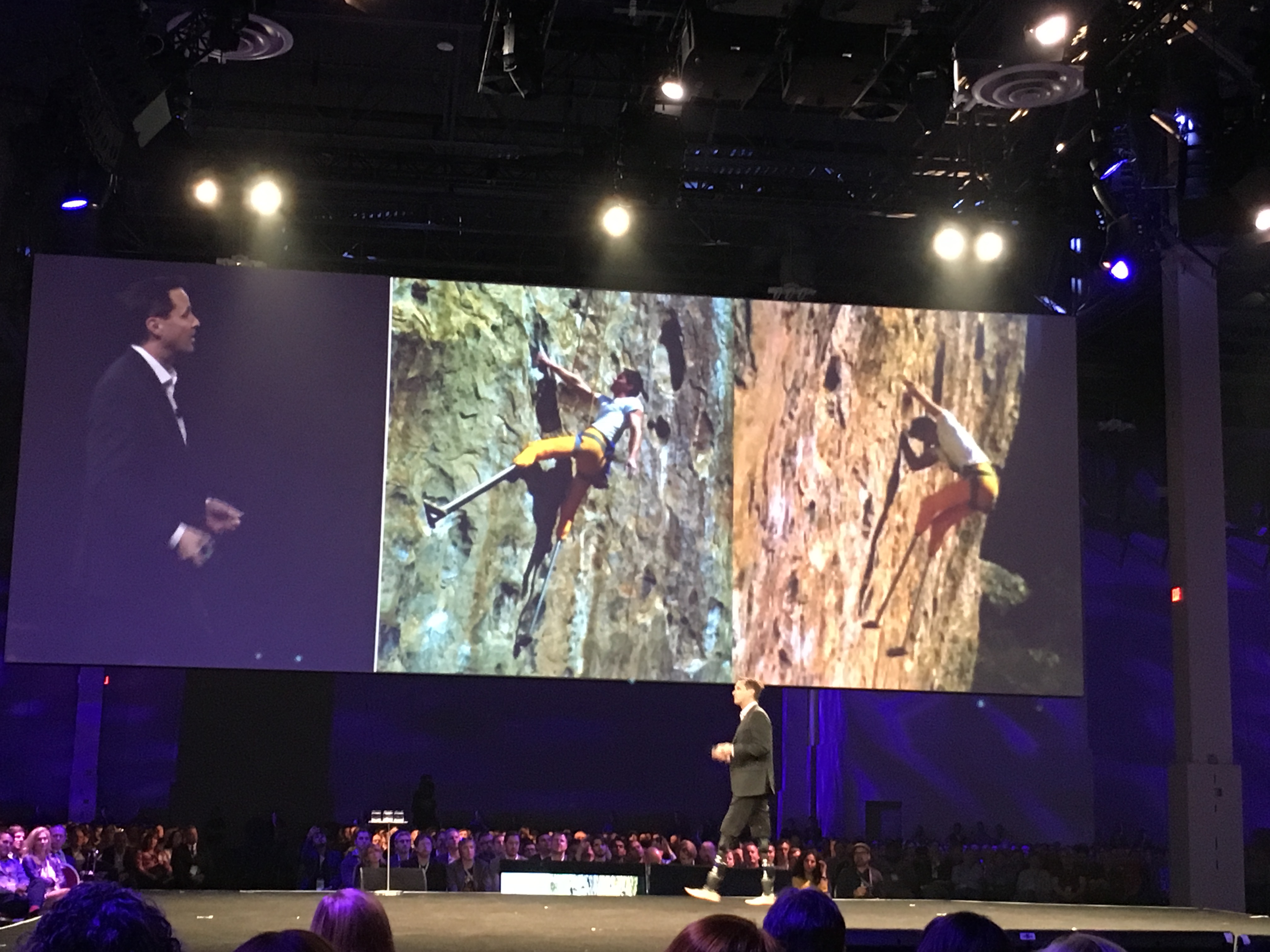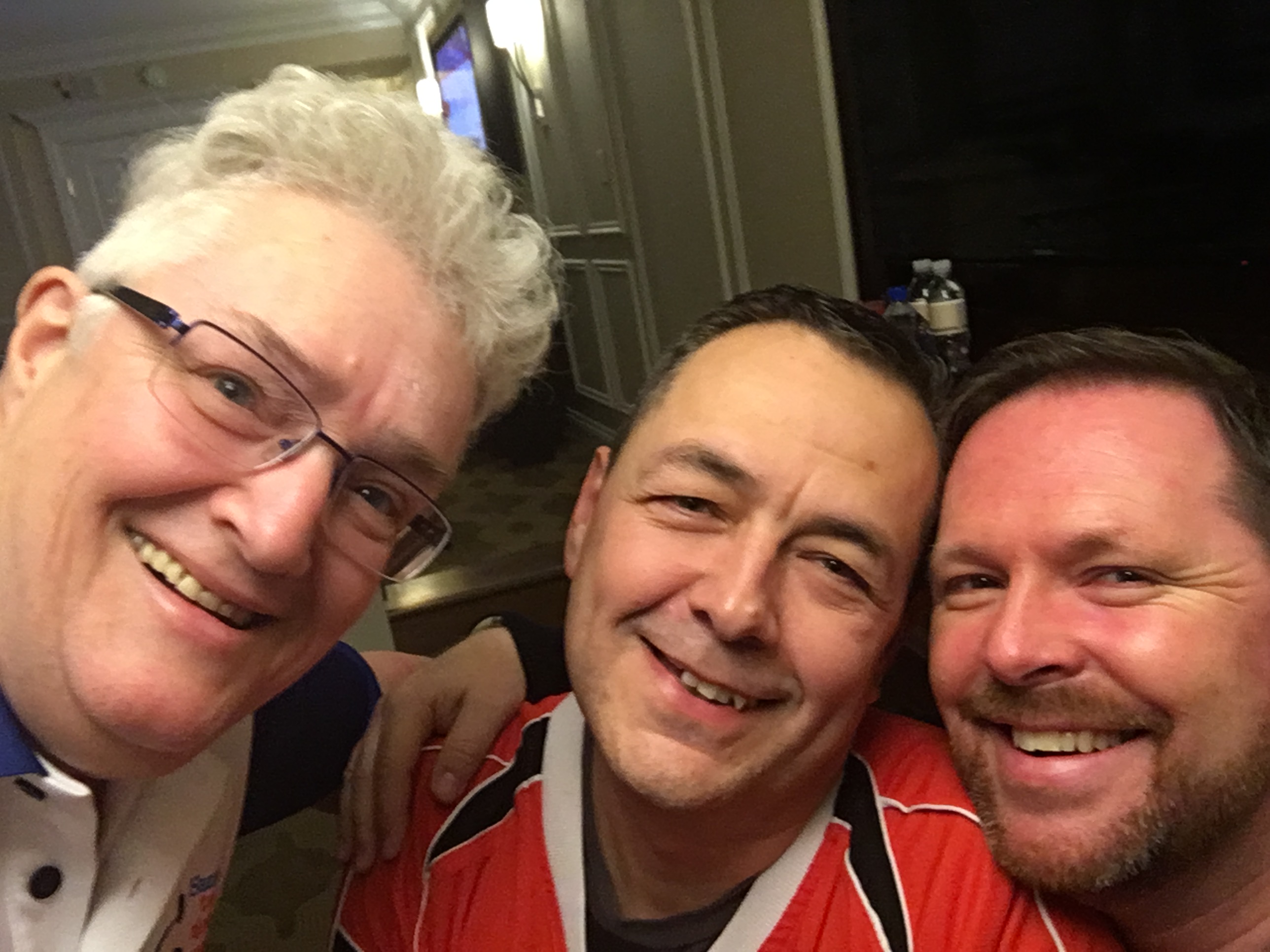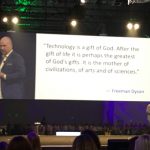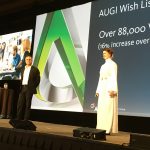So here I am again. Autodesk University 2015 (#AU2015) in the land of Lost Wages, or as it says on the map, Las Vegas. The land of beautiful sunrises, bright lights and an excess of crazy entertainment. And, you can gamble to your hearts content too.
Well, all of that aside, I am here attending Autodesk University (AU) again and I just want to impart my knowledge and experiences from AU to you, ranging from the opening keynote from Carl Bass to my thoughts on the AU event this year.
The first big event at AU is always the opening keynote from the head honcho over at Autodesk, Inc. Entering the keynote was like entering an Ibiza nightclub, with throbbing techno beats and mixes of chart hits. A big nightclub for the Autodesk nerds and geeks, you might say, with DJ’s doing their thing on the decks, under the bright lights.
Various sponsor ads adorned the big screens, including ads for AU sponsors such as Amazon Web Services, Lenovo and HP, along with an ad for Microsoft HoloLens from Autodesk VP, Lisa Campbell. You could book sessions with the HoloLens at AU, but these were booked up thick and fast from day one!
As I am sure you all know, the opening of the new Star Wars movie is upon us. The music in the arena changed to a jazzy Star Wars theme tune and out marched numerous Stormtroopers, escorting Autodesk darling and Technical Evangelist, Lynn Allen to the stage, ready to open the key note. As Donnie Gladfelter (The CAD Geek – http://thecadgeek.com/) quoted, she managed to outnerd 10,000 nerds. Check out the video on my Flickr account here: https://flic.kr/p/C3T4Wm.
As usual, Lynn introduced Carl Bass (CEO – Autodesk, Inc.) and thus the keynote began, which sets the theme of AU each year. Carl began with a company who have developed and created “dovetail” structural steel joints, followed by how amazing the new Apple HQ will be in Cupertino, CA, which has been designed by a well-known British architect, Norman Foster (http://www.fosterandpartners.com/). The Apple HQ is being built using pre-fabricated concrete panels which are ALL catalogued and monitored, even the ones in the car park! All using new and emerging technologies, where building and manufacturing are converging.
The Internet of Things (IoT) is beginning to get bigger, with machines diagnosing and repairing themselves. Bass talked of his experiences of getting his noisy lathe diagnosed with a smartphone strapped to it inside a ZipLok bag. His point was that it would be great if machines could listen to themselves and the diagnose the problem and fix themselves.
Bass continued to discuss the drought of talented people who think innovatively and in a certain way, and how to recruit those people. Bass used an example of drinks bars being available in the Facebook HQ on each floor. He said he found it odd that Facebook needed these kind of enticements to get staff and wondered if this was the best way to get people working for you.
Bass then went on to highlight some of the amazing projects that some of the Autodesk interns have worked on in the last year and how they wanted to work on things that mattered, instead of having the incentive of a drinks bar on each floor. The old way or recruiting is changing. Free food is not the big sell anymore, people want to work for companies who offer them the opportunities to work with passion and create their best work.
Bass then hands the stage to Andrew McAfee (MIT) who discusses what have been the most important developments in human history. Imagine that as a dinner party question at a dinner party full of geeks. What does the geek say?
The geek would turn the timeline in to a graph, and from that we can extrapolate that nothing has affected human development as much as the technology story and path. But what about the consequences? Trees cut down, killing whales, using children in factories….
McAfee went on to talk about a book by William S Jevons called The Coal Question, which raised the question of being healthier and wealthier, but the population was exploding. So innovation kicked in and what happened? As we moved forward, we used concrete instead of wood, kerosene instead of oil. This is known as dematerialization, where we are now past the point of peak use of raw materials, which is now a “profound trend”. We are now moving with large scale computerization to dematerialize with the investment in software and equipment going up year upon year. There is a bottomless quest for software and code to create more environmentally sustainable buildings using Autodesk software.
McAfee quoted that we have two remaining challenges: –
- Stop cooking the planet to avoid climate change
- The labour force is now doing less and less due to technology
These are important changes where we are seeing corporate profits going up and salaries going down, with the labour share of income getting lower and lower.
McAfee then went on to use two famous quotes to end his session; one from Winston Churchill in 1949 just after World War II and another from Freeman Dyson.
Jeff Kowalski (CTO – Autodesk, Inc.) then took the stage. His first quote was that in the next twenty years we will have more change than in the last 2,000 years with the next age being the AUGMENTED age, with computation systems that help, make, work and think. Tools we use will move from PASSIVE to GENERATIVE, using algorithms to develop many design ideas at once. He used the example of a panel design used for aircrew seating in an Airbus aircraft, that used generative design. It is changing aircrew seating by designing a lighter, stronger panel that saves 500,000 tonnes of steel in weight, thus reducing aircraft emissions to the equivalent of having 96,000 less cars on the road.
Kowalski then went on to state that we would start to use INTUITIVE design tools, such as advanced machine learning systems that remember and use patterns. They would then also be EMPATHIC by working with us, remembering our preferences. Kowalski closed with the example of Bishop, an Autodesk robot in the Autodesk Applied Sciences Lab, developing HIVE, a pavilion that is being designed by both human and robot, which was an exhibit at AU2015 this year.
Kowalski then handed the stage to what was to be a presentation that I, personally, found to be both amazing and inspirational. Dr Hugh Herr (MIT) builds prosthetic body parts. He is the most incredible human being. He lost his legs to frostbite when mountain climbing and after surgery, he asked if he would ever climb again. He was told no, so against all odds, he began to develop a set of new, bionic legs that would allow him to climb again.

As Herr quoted, he used technology to heal himself and rehabilitate to the point where he is now actively climbing again using a set of bionic legs he has developed in the incredible field of bionics. Herr’s story is as inspiring as it is amazing, both with the human story and the incredible use of technology where he is using nano mapping of the brain and the body to develop robots to measure the body and design bespoke bionic body parts of each individual. As Herr quoted, without technology, he is a cripple, but with technology, he is free.
Kowalski then took the stage again, commenting on how we are now designing a nervous system connecting us to the objects around us; buildings, toys, cars. He used a humourous example of the drinks and snacks provided in Las Vegas hotel rooms where if you moved an item, the sensor under it charged it to your room. And speaking of Vegas hotels, housekeeping arriving at the wrong time. Maybe a sensor should be designed to let housekeeping know that you need privacy, such as when the shower is in use or when you are asleep, instead of the usual “Do Not Disturb” sign on the door handle. What sort of waving action should be used for a paper towel dispenser? Kowalski demonstrated, much to the amusement of his audience. Kowalski went on to talk about web designers designing down to pixel size and imagining that kind of information coming to you as a user of technology. Kowalski then went on to quote that we should be making “stuff that people want”.
Kowalski’s closing example of the use of technology was Bandito Bros, a crazy car company who develop cars that jump huge distances and loop the loop in real life, in the same way that our Hot Wheels used to when we were children. They are working with Autodesk, developing an intelligent car with a nervous system, calculating every move a car makes. The information gained allowed a generative car chassis to be developed and manufactured using Autodesk Dreamcatcher.
Kowalski closed the session with the quote:
“The future….the AUGMENTED age”.
As always, I thoroughly enjoyed my time at AU this year. It is a time to learn, network and meet old friends and make new ones. A high point for me was the Blogger Social held by Shaan Hurley (Autodesk, Inc.). This year we were treated to a 3D print of the USS Arizona that was sunk in Pearl Harbour, Hawaii, in WW2. This was an Autodesk special project headed up by Pete Kelsey (Autodesk, Inc.) in conjunction with the US National Parks Service where LIDAR, photogrammetry and reality capture were used to create a 3D model of the sunken ship in order to monitor and maintain it. You can check out Shaan Hurley’s blog, Between The Lines, where he writes about the project here: http://autodesk.blogs.com/between_the_lines/2014/07/3d-prints-of-uss-arizona-artifacts.html.
Another great moment was the Autodesk User Group International (AUGI) Annual General Meeting (AGM). As a serving Director on the Board of Directors for AUGI, I can safely say that the organisation is very close to my heart, and this year, the presentation excelled with the use of Bob Bell’s lightsabre, combined with Kate “Leia” Morrical and Curt “Obi Wan” Moreno. The nerd humour in that half an hour made my AU. Total nerd humour at its best.
If you are yet to become an AUGI member, why not sign up? Just head on over to www.augi.com, and sign up for the Basic membership. It’s free forever and if you like it, consider a paid Premier ($25/annum) or Professional ($100/annum) membership later on to gain even more AUGI benefits such as the printed version of AUGIWorld magazine as a Professional AUGI member.
This was my ninth AU, and I have to say that whilst the Vegas lights and dry desert air can be somewhat intolerable at times (make sure you get a humidifier for your hotel room), the people attending more than make up for it. You can learn what you need from world class speakers, socialise with Autodesk rock stars such as Lynn Allen and Shaan Hurley and, most importantly, make contacts that often will stay with you for the rest of your working lifetime. I have made friendships at AU that, whilst based on a professional standing, will be friends for life. These are people that share my nerd humour and have become people that you can talk to about all things Autodesk, but can also share a beer or a coffee with as well.

Another little bonus this year was the chance to jam with some of my Autodesk muso buddies too. On the Tuesday night of AU, we hopped out to the city limits to a small rehearsal space to crash out some tunage. We had the remarkable talents of Teresa, Casey, Anthony, Brian, Robert, Steve and Guillermo, plus myself, and we had a blast kicking out some classic rock tunes. My highlight of the night was performing lead vocal to ZZ Top’s Sharp Dressed Man…..
So, now back in the cold, grey UK, I do miss the bright lights of Vegas, but not for the same reasons some people do. I miss the Autodesk camaraderie, the nerd humour and the buzz of being in a place where approximately 10,000 other Autodesk nerds get together to learn, network and share (and maybe, just maybe, grab a beer or two!).
I have set up a Flickr account to upload all of my photos from AU, so check them out here.
Autodesk University Las Vegas 2016 will be held at The Venetian Hotel and Casino between November 15 – 17, 2016. So save the dates in your diaries!
Happy CADD’ing!
SCB









